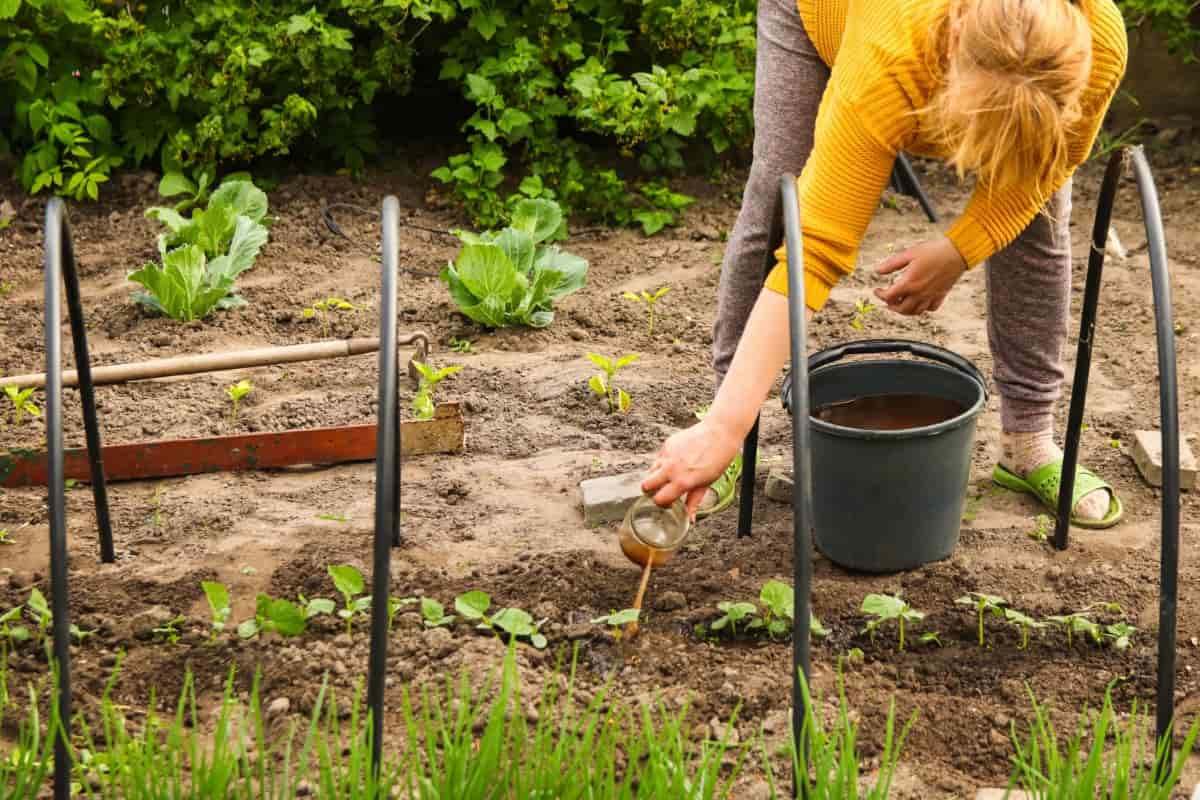You can feed your lawn properly with organic liquid lawn fertilizer without harming the environment, which helps ensure a lush, healthy lawn. By making your own organic liquid lawn fertilizer at home, you can ensure your lawn receives the nutrients it needs to thrive while contributing to a more environmentally friendly approach to lawn care. This guide will briefly discuss step-by-step instructions for creating organic liquid lawn fertilizer.

How to Make Organic Liquid Lawn Fertilizer at Home
Understanding the Benefits of Homemade Organic Liquid Lawn Fertilizer
- Firstly, it is free from harmful chemicals, reducing the risk of chemical runoff into water sources.
- Additionally, organic fertilizers enhance soil fertility and promote the growth of beneficial microorganisms, improving the overall health of your lawn.
- Homemade liquid fertilizers are also cost-effective, as you can easily make them using common household ingredients like compost, seaweed, or grass clippings.
- These natural alternatives provide a slow release of nutrients, ensuring steady and sustained growth for your lawn.
- Opting for homemade organic liquid lawn fertilizers allows you to achieve a lush and vibrant lawn while minimizing environmental impact.
Essential Ingredients for Homemade Organic Liquid Lawn Fertilizer
- Grass clippings: Collect the grass clippings from your lawn after mowing. These clippings contain essential nutrients that can be used to nourish your lawn.
- Weeds: Gather weeds from your garden or yard. While weeds may be considered a nuisance, they are nutrient-rich and can benefit your lawn when used as fertilizer.
- Vegetable scraps: Save your vegetable scraps such as peels, cores, and spoiled vegetables. These scraps are a great organic matter source and nutrients that can be used to fertilize your lawn.
- Epsom salt: Epsom salt, also called magnesium sulfate, is a mineral compound that naturally provides vital nutrients to your lawn. It is particularly beneficial for promoting healthy root growth.
- Water: You will also need water to create the liquid fertilizer. Water helps to extract the nutrients from the organic ingredients and makes the fertilizer easy to apply.
Step-By-Step Guide to Making Homemade Organic Liquid Lawn Fertilizer
Prepare the Container: Find a large container, such as a bucket or a barrel, to hold your fertilizer mixture. Ensure the container has a lid or cover to prevent unwanted pests or animals from accessing it.
Collect Organic Material: Collect grass clippings, weeds, and vegetable scraps from your garden or kitchen. These organic materials will provide essential nutrients for your lawn.
Mix the Ingredients: Fill the container with the collected organic material. Add a handful of Epsom salt rich in magnesium and sulfur to promote healthy grass growth. Then, add water to cover the organic material completely.
Let It Ferment: Cover the container with a lid and let the mixture ferment for 2-3 weeks. The organic material will decompose during this time, releasing nutrients into the water.
Strain the Mixture: After fermentation, strain the liquid from the solid material using a fine mesh sieve or cheesecloth. The resulting liquid is your homemade organic liquid lawn fertilizer.
Apply to Your Lawn: Dilute the liquid fertilizer with water at a ratio of 1:10, meaning one part fertilizer to ten parts water. Use a watering can or else soaker hose to distribute the fertilizer over your lawn evenly. Apply this diluted solution every 2-3 weeks during the growing season.
The Science Behind Organic Nutrient Delivery in Liquid Form
- In a bioavailable form, liquid organic fertilizers are formulated to have a balanced ratio of essential nutrients, such as nitrogen, phosphorus, and potassium.
- These nutrients are extracted from natural sources, such as kelp, fish emulsion, and compost.
- The liquid form allows for easy application and rapid uptake by plant roots.
- Additionally, organic liquid fertilizers contain beneficial microorganisms that promote soil health and enhance nutrient availability.
- This ensures that plants receive a steady supply of nutrients, resulting in healthier growth and improved yields.
Comparing Homemade Organic Liquid Lawn Fertilizer to Commercial Alternatives
When it comes to lawn fertilizers, comparing homemade organic liquid options to commercial alternatives is essential. Homemade organic liquid fertilizers offer several advantages. They can be made using common household ingredients such as compost, grass clippings, or seaweed. These natural ingredients provide essential nutrients to the soil, promoting healthy grass growth. Homemade organic liquid fertilizers are also environmentally friendly, as they do not contain harmful chemicals.
In case you missed it: Application of Amino Acid Liquid Fertilizer: How to Use in Agriculture

On the other hand, commercial alternatives are convenient and readily available. They often come in concentrated forms, making them easy to apply. However, they may contain synthetic chemicals that can harm the environment and potentially leach into groundwater. Choosing between homemade organic liquid fertilizers and commercial alternatives depends on personal preferences and environmental concerns.
Tips for Proper Application and Dosage of Homemade Organic Liquid Lawn Fertilizer
- Measure Accurately: Use a measuring cup or a calibrated sprayer to ensure you apply the correct amount of fertilizer. This will prevent over or under-fertilization.
- Follow the Instructions: Homemade organic liquid fertilizers may have different application rates, so it’s important to follow the specific guidelines the recipe or manufacturer provides.
- Apply Evenly: Use a sprayer or watering can to distribute the fertilizer across the lawn evenly. This will help promote uniform growth and prevent patchy areas.
- Time it Right: Apply the fertilizer during the early morning or late afternoon to minimize evaporation and maximize absorption.
- Water After Application: To ensure the fertilizer reaches the roots, water the lawn lightly after applying the liquid fertilizer.
Common Mistakes to Avoid When Making and Using Homemade Organic Liquid Lawn Fertilizer
- Firstly, too much fertilizer can harm your lawn and produce burned patches. It is advisable to follow the recommended application rates and avoid overdoing it.
- Secondly, not properly diluting the fertilizer can also cause damage to your lawn. Always make sure to mix the fertilizer with water according to the instructions.
- Lastly, not applying the fertilizer evenly can lead to uneven growth and patchy areas. Take your time and apply the fertilizer evenly across the entire lawn.
Environmental Impact of Homemade Organic Liquid Lawn Fertilizer
Homemade organic liquid lawn fertilizers are an excellent option, made from natural ingredients such as compost, seaweed, and fish emulsion. These ingredients provide essential nutrients for the grass, improve soil health, and encourage beneficial microbial activity. One of the major benefits of using homemade organic liquid lawn fertilizers is their minimal environmental impact.
Unlike chemical fertilizers, which can leach into groundwater and pollute nearby water bodies, organic alternatives are gentle on the environment. They do not contain harmful synthetic chemicals that can harm beneficial insects, birds, and other wildlife. Moreover, homemade organic fertilizers are easily biodegradable, reducing the risk of long-term environmental damage.
Long-Term Effects and Sustainability of Homemade Organic Liquid Lawn Fertilizer
One of the key advantages of homemade organic liquid lawn fertilizer is its long-lasting effects. Unlike synthetic fertilizers, which provide a quick release of nutrients but often lead to soil depletion, organic fertilizers promote soil health and microbial activity over time. This results in improved soil structure, enhanced water retention, and increased nutrient availability for your lawn.
In case you missed it: How to Make Liquid Fertilizer from Kitchen Waste: DIY, Simple Preparation Steps

Additionally, homemade organic liquid fertilizers are sustainable. Utilizing readily available ingredients and reducing reliance on chemical products can lower your carbon footprint and contribute to a more environmentally friendly lawn care routine. Furthermore, organic fertilizers help to minimize water pollution by preventing excess nutrients from leaching into groundwater and nearby water bodies.
Conclusion
In conclusion, making organic liquid lawn fertilizer at home is an easy and environmentally friendly way to nourish your lawn. Using natural ingredients like compost, grass clippings, and water, you can create a nutrient-rich solution promoting healthy growth and greenery. Give it a try and enjoy a vibrant and flourishing lawn.
- Feed Your Flock for Less: Top 10 Tips to Save on Chicken Feed
- Ultimate Guide to Ossabaw Island Hog: Breeding, Raising, Diet, and Care
- Hatching Answers: The Top 10 Reasons Your Chickens Aren’t Laying Eggs
- Eggs and Economics: Breaking Down the Cost of Raising Backyard Chickens
- Defend Your Greens: Proven Methods to Keep Iguanas Out of Your Garden
- Ultimate Guide to Cinnamon Queen Chicken: A Comprehensive Guide for Beginners
- Ultimate Guide to California Tan Chicken: Breeding, Raising, Diet, Egg-Production and Care
- Ultimate Guide to Marsh Daisy Chicken: Breeding, Raising, Diet, and Care
- 10 Types of Chicken Farming Businesses You Can Start for Profits